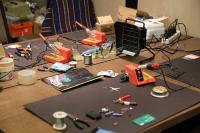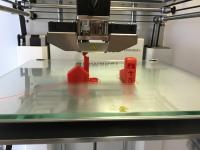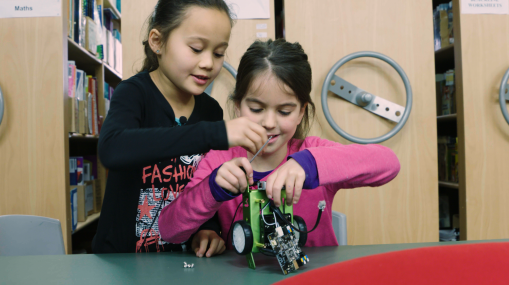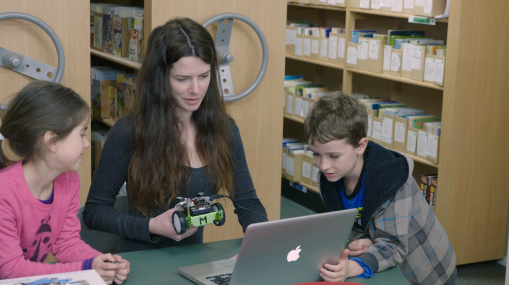Makerspaces
What are makerspaces?
Makerspaces are collaborative workshops where young people gain practical hands-on experience with new technologies and innovative processes to design and build projects. They provide a flexible environment where learning is made physical by applying science, technology, math, and creativity to solve problems and build things.
Kim Baars describes the learning taking place in Maker classes at Taupaki School. Kim talks about teachers and students working together in collaborative problem-solving, and the powerful differentiation taking place in the makerspace. (Filmed September 2015)
Julie McMahon shares how year nine students at St. Hilda's Collegiate School have used the creative side of electronics and programming to create e-textiles garments.
Makerspaces in school
"Wherever making happens is a makerspace"
Burke, 2014
- A makerspace can be any space in your school where students and teachers come together to create, invent, prototype, design, tinker, explore, discover, code, build, craft, draft, draw and more.
- Students can work individually or collaboratively using a variety of high and low-tech tools and materials.
- Makerspaces typically have a STEM focus (Science, Technology, Engineering, and Maths). However, makerspace is an ideal platform for projects that work across all subject areas.
Whānau and community engagement through makerspaces
"Learning environments rich with possibilities, makerspaces serve as gathering points where communities of new and experienced makers connect to work on real and personally meaningful projects, informed by helpful mentors and expertise, using new technologies and traditional tools."
Having a makerspace is a perfect opportunity for whānau and community engagement
-
Whanaungatanga – Involve whānau in makerspace projects
The makerspace offers an opportunity for whānau to get involved in their child's learning. They can participate in making, workshopping ideas, or helping to judge and evaluate projects.
-
Bring in an expert
Identify parents, whānau, and wider community connections that have a trade or craft. Bring them into your makerspace to offer advice or teach a skill.
-
Engage with local businesses
Ask your local architecture firm, manufacturer, or tech company to get involved. They might have not only expert advice to offer, but also spare equipment and materials.
-
Tuakana-teina
Having an older or more expert learner help and guide those who are younger is an effective way for students to share expertise and learn together. The makerspace is an opportunity to develop tuakana-teina relationships.
Makerspaces in New Zealand
Making horizontal connections through makerspaces
Because knowledge-sharing is at the heart of the maker movement, individual makers can draw on a wide range of expertise and human resources. No question is too simple. Encourage students to post on the relevant forums and contact the right experts for help with their projects. Even if your makerspace is in a repurposed shed on the edge of the school grounds, it will essentially be part of a broader community – a local and global culture of making.
For students involved in makerspace, this culture of sharing encourages making connections and working collaboratively with people relevant to their project goals.
Hubs to access the NZ maker community
A national network of people interested in community, new-digital literacy and/or making and learning in New Zealand.
Makerspace technology recommendations for businesses and classrooms.
Beyond New Zealand
Once you've established your makerspace, sign up to makerspace.com to join the Makerspace list and connect with makers around the world.
Maker culture and school vision: Getting your staff on board
Stephen Lethbridge (former principal at Taupaki School) talks about how they initially implemented maker culture at Taupaki School. He outlines the importantance of having involvement and support from the board and teachers. Stephen explains some of the barriers schools might face and what they can do to overcome them. (Filmed September 2015)
The maker movement
Makerspaces around the world are part of a growing movement of hands-on, mentor-led learning environments that celebrate grass roots innovation and DIY (Do-it-yourself) culture. At the core of the the maker movement is the notion that we aren't just passive consumers of new technologies – we can be producers too.
Maker faire
The cultural epicentre of the maker movement is the Maker Faire – an all-ages gathering for hobbyists, educators, students, designers, tech-enthusiasts, artists, and engineers to show-and-tell their latest DIY projects and innovations. The first maker faires were organised by Make Magazine , the defining publication of the maker movement in the US, but local maker communities have since popped up all over the world. Makers tend to stay connected through online community spaces and social media, as well as through their local makerspaces.
Sharing
A guiding principal of maker culture is sharing. This includes sharing of knowledge and technologies; tools and materials; techniques, skills, and ideas; and more importantly – the projects created in makerspaces.
References
1 Maker Media, (2012) High school makerspace tools and materials . Make Magazine
2 Burke, John J, (2014) Makerspaces: A Practical Guide for Librarians. Washington, D.C. Rowman & Littlefield Publishers.
3 Maker Media, (2013) Makerspace playbook: School book edition . Make Magazine.
A makerspace can be embedded in an existing part of your school or stand alone. A makerspace could be in a classroom, library, shed, garden, or hallway. It could even be a pop-up or mobile makerspace. It's not about the space, but the culture and mindset that the space promotes and develops an innovation mindset.
Former principal, Stephen Lethbridge and teachers explain the development of their makerspace in 2015.
Where to put your makerspace
Choices of location for makerspaces vary from school to school according to resources and learning goals. Some are purpose-built for particular kinds of projects, with a permanent fit-out of equipment and tools. Others are distributed throughout the school, with multiple locations (e.g. home-economics room, music room, computer lab) co-opted towards making.
"The best makerspace is between your ears."
The library
The school library is often the hub of the school and easily accessible by all students.
The computer lab
Instead of updating old desktop computers, some schools are taking advantage of BYOD capabilities. Students come and go with their laptops and iPads, allowing desks to be cleared for making.
The classroom
Any classroom can be transformed into a makerspace. The furnishing in makerspace classrooms is organised in a way that allows for both collaborative and individual work.
Outdoors
Making outdoors is an opportunity to solve problems, innovate, and create through gardening.
More information »
- Makerspace Playbook (p.6) – information about selecting a location for your makerspace
-
Tools and materials
"A collection of tools does not define Makerspace. Rather, we define it by what it enables: making."
Makerspaces range from the ultra high-tech "fab-lab" (small scale workshop replete with 3D printers, scanners, and laser cutters) to a classroom desk scattered with recycled materials and tools.
The tools and equipment in your makerspace's inventory depend on:
- your educational goals
- your students' creative interests
- your budget.
Common makerspace tools
Inexpensive
- Arduino microprocessor – Getting started with Arduino (guide)
- Rasberry Pi microprocessor –
- Makey Makey invention kit – Makey Makey lesson plans
- Hand Tools
- Art utensils
- Lego
- Student-generated list of consumable materials
High-end
- 3D printers – 3D printing in the classroom (web resource)
- Power Tools
- Laser Cutter
- Soldering kit
- CAD workstations and other 3D design software
More information »
- Safety in Technology Education - A guidance manual for New Zealand schools.
- Makerspace Playbook p.10 – A comprehensive guide on toolkits for makerspaces.
Safety
Identify safe practices and potential risks and hazards with your students
-
Model safe behaviour
- Post safety guideline signs on tools
- Remove hazards by keeping your space clean
- Check that there is proper ventilation to your space
- Watch out for extension cords and other tripping hazards
- Make sure there is enough space for students to work comfortably
- Keep a well-stocked first-aid kit visible and easily accessible in your space
- Provide personal safety equipment such as goggles, earplugs, gloves, etc.
- Decide on and develop some common makerspace rules
More information »
References
1 Joachim Cohen, (2016) Everything you need to know about makerspaces . Splash ABC.
2 Gary Stager, (June 10, 2014) "Gary Stager’s Full ASCD Interview About Making.” Stager-to-Go (blog). June 10, 2014
3 Maker Media, (2013) Makerspace playbook: School book edition . Make Magazine.
Makerspace learning
"At the heart of the maker movement is this mashing together of traditionally siloed areas. Art, technology, design, music, film, science all come crashing together in the maker movement."
Mark Osborne
Stephen Lethbridge (former principal of Taupaki School) and students explain how they solve real problems during learning. (Filmed September 2015)
Examples of learning
The types of learning and creating that can be done in a makerspace are limitless.
Coding
Build a morse code virtual radio using a Raspberry Pi microcomputer, morse tapper key, speakers, and some jumper wires.
Similar lesson plans are available with coding instructions at www.raspberrypi.org .
Key Skills: Circuitry, electronics, coding, digital fluency, STEM, problem-solving.
Interdisciplinary potential: This lesson could add authenticity to a history project about war-time communications.
More information »
3D printing
Students learn about an object they are researching (e.g. planet earth, the sun, a plant, the pyramids, a body part) by creating a 3D-printed model of it.
Students print parts needed to build an object e.g. a movable robot that is controlled through coding.
Key Skills: CAD design, maths, art, engineering, fabrication.
Interdisciplinary potential: all subject areas.
3D printing lesson plans:
Robotics
Use mobile apps to code a programmable robot like sphero , cubelet , or dash and dot so that it emulates human emotions or character traits through its movements and behaviour.
Key Skills: Coding, literacy, performance, programming, digital fluency.
Interdisciplinary potential:This activity would suit a drama or literacy focus exploring character development, or a lesson exploring key concepts in psychology.
More information »
Technology
Challenge students to solve a problem in your school using cardboard.
Key Skills: design, problem-solving, collaboration
Interdisciplinary potential: art, design, maths, technology
More information »
Teachers at Taupaki School explain how their makerspace encourages students to collaborate. (Filmed September 2015)
More makerspace ideas
MakerED p ublications
Makerspace resources and programming ideas
60+ makerspace ideas for education
Benefits of makerspaces
The most important benefits of maker education are neither STEM skills nor technical preparation for the next industrial revolution. Though these benefits may accrue along the way, the most salient benefits of maker-centered learning for young people have to do with developing a sense of self and a sense of community that empower them to engage with and shape the designed dimension of their world.
Benefits of maker spaces for learners
-
STEM skills
Makerspaces provide authentic contexts for students to develop 21st century skills such as digital fluency, design acumen, and knowledge of coding and robotics.
-
Student inquiry
Inquiry-based learning is embedded in maker culture. The open-ended nature of makerspace work is the perfect setting for ideating, solving problems, developing hunches, experimenting, and reflecting. Makerspaces give learners the chance to fail and try again until personal goals are achieved. "Play" is a key component.
-
Learner agency
Makerspaces are about choice. Students can set their own learning goals and decide for themselves the tools and materials they will use. Makerspace projects are ideal opportunities for solving real-world problems. Projects provide authentic contexts for student voice. "Empowerment" is a key concept.
-
Making horizontal connections, social learning, and co-construction of knowledge
Makerspaces are built on a culture of collaborative learning. They reach their full potential when they operate as communal spaces that connect mentors with peers and allow them to tinker, explore, and create together. For students, this means asking experts from the local community to participate in makerspace work, as well as drawing on the many makerspace communities available online. "Community" is key.
References
1Agency by Design. (2015). Maker-centered learning and the development of self: Preliminary findings of the agency by design project . Harvard Graduate School of Education
2Kurti, S. R., Kurti, D. L. & Fleming, L. (2014). The Philosophy of Educational Makerspaces. Teacher Librarian.
Filter by: Collaborative learning Collaborative tools Future-focused learning Secondary Video conferencing Pasifika Inclusion Community engagement Whānau engagement
Sorry, no items found.
Resources and readings
School guides
High school makerspace tools and materials
A comprehensive guide for schools and teachers looking to establish makerspaces in this US publication from Make Magazine. Prices of tools and equipment are in American dollars.
Makerspace playbook: School book edition
.
An in-depth guide on school makerspaces from Make Magazine.
Information on tools, projects ideas, and research on makerspaces. MakerED is a non-profit organisation devoted to making and youth empowerment.
Related Enabling e-Learning pages
New Zealand makerspace community hubs
A national network of people interested in community, new-digital literacy and/or making and learning in New Zealand.
Makerspace technology recommendations for businesses and classrooms.
Community hubs beyond New Zealand:
Sign up to makerspace.com to join the Makerspace list and connect with makers around the world.
Makerspaces around New Zealand
Tool and project guides
High school makerspace tools and materials
A comprehensive guide for schools and teachers looking to establish makerspaces in this US publication from Make Magazine. Prices of tools and equipment are in US dollars.
Guide for educators wanting to incorporate microprocessors and coding into their practise
Rasberry Pi in education (weblinks and resources)
Resources for incorporating the Raspberry Pi into lessons.
Ideas and guides for using Makey Makey in the classroom.
Web resources and lesson ideas for using 3D printing to enhance learning.
Web site specialising in user-created do-it-yourself projects. A source of inspiration and know-how for making.
Readings
Key reading
Makerspace: Highlights of select literature
Steve Davee, Lisa Regalla, and Stephanie Chang conduct a thorough review of the research available on makerspaces in education.
Mark Osborne outlines why maker culture is one of the 10 trends in education.
Makerspaces in the school library environment
The benefits of setting up a makerspace in your school library, a publication by Megan Daley and Jackie Child.
Everything you need to know about makerspaces
Joachim Cohen gives an update on what's happening in schools in Australia and around the world.
Gary Stager’s Full ASCD Interview About Making
Makerspace thinker, Gary Stager discusses the maker mind-set.
The pedagogical benefits of makerspaces are discussed in this Harvard Graduate School of Education research.
Report outlining how two teachers set up a Makerspace and developed an action research project with the support of the CORE Education eFellowship.



















